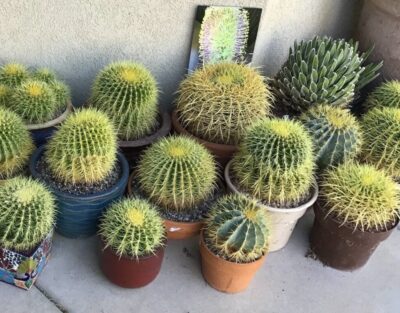Bringing cacti and succulents indoors for the winter
By Kate Weissenburger & Don Campbell
September 2022

Here in the Grand Valley September marks the time when we start thinking about the first frost and making plans to bring our cold-sensitive cacti and succulents indoors for the winter.
This sounds as if it ought to be pretty straight forward but, like many things horticultural, it’s not. A few years ago I did a bit of canvassing among Club members and found that no two people, never mind three or more people, follow quite the same procedure. So, here is a smorgasbord of some of the better thoughts and ideas culled from our members.
A lot of our cold sensitive cacti and succulents are outdoors in the summer because we don’t have enough natural light for them to grow well indoors, and we don’t want to be bothered with grow lights and the like. If that is the case, in general terms when you bring them inside for the winter you are going to force them into dormancy.
Start preparing them for the big move a few weeks ahead of time:
- Start cutting back on water.
- Give them a shower.
- Examine for pests and pathogens and treat or cull as necessary — you really don’t want to be bringing scale, mealy bugs, mites, fungi and the like inside.
- Now would be a great time to treat with a systemic insecticide even if you don’t see evidence of critters. Many of us use imidacloprid as a soil drench. Bayer 3-in-1 Insect, Disease & Mite Control is a good choice because it does not contain a fertilizer.
- Resist the temptation to fertilize.
Bring the cacti and succulents inside. Since you are forcing dormancy you will want to keep them at a fairly cool temperature. But here our member’s strategies tend to differ.
- Cacti can be kept in total darkness for the winter if the room temperature is cold, say around 45 – 55°F and water entirely withheld during the winter. This is an extreme strategy but it works for some members.
- A more “moderate” strategy is to place them in an unheated room (like a garage) that receives some light and water the plants infrequently: every month or so.
If you are in the moderate watering camp, don’t despair if you don’t have an unheated room but do be sparing with water. And by all means be cautious about placing the plants on a window sill in direct sunlight during the forced dormancy –– the winter sun can be blazingly hot and with the low sun angle you risk burning the plants, or worse.
Water when the soil is well and truly dry. Your watering strategy depends on the type of soil mixture you are using and whether or not the root mass fills the pot. If the mixture contains peat or some other material that becomes hydrophobic (resistant to water) when it dries, then top-down watering is not going to be effective: the water will simply run down the sides and out the bottom of the pot. Bottom-up watering will be more effective in this case: set the pot in a saucer or pot of water so that the water can wick up upwards until the soil is re-hydrated. If the soil is not hydrophobic when dry then top-down watering works just fine. Water until it starts to run out the bottom of the pot. With either method, don’t let the pot stand in water for long after the soil has re-hydrated.
If you are a winter waterer, remember that you are only trying to prevent the roots from getting completely desiccated for a prolonged period of time.
And a final note: non-cacti succulents will probably need somewhat more frequent winter watering than cacti.
